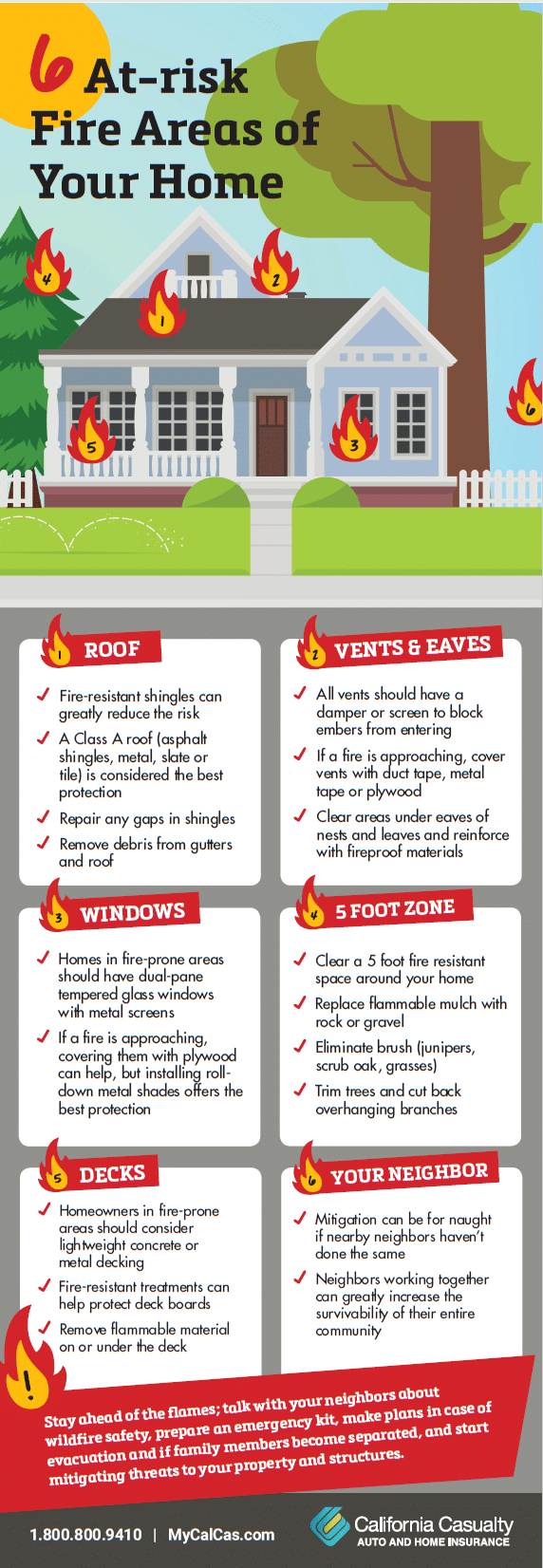Wildland fires are becoming the new norm across much of the country, scorching more acreage with a ferocity that firefighters have not seen before. Now, more than ever, it’s important to understand fire behavior and the ways to prepare your home and community.
Don’t let your family’s possessions go up in smoke. The difference of a home in ashes and one still standing is often the result of simple actions taken to make the structure more survivable to heat, flame and embers. Removing bush, trimming trees, and creating 30-100 feet of defensible space is the best line of defense, but there is a lot more that homeowners and renters need to do.
As more people move into wildfire-prone areas, it’s imperative that we understand the areas around a house that are the greatest risk. Fire research has discovered blowing embers, not direct flames, cause most homes to ignite.
Here are the 6 most at-risk most vulnerable fire areas in and around your home.
- The Roof– This is the largest surface area on your home. Installing fire-resistant shingles can greatly reduce the risk. A Class A roof (asphalt shingles, metal, slate or tile) is considered the best protection. Repair any gaps in shingles and remove debris from plants or animals that an ember could nest in and ignite. Keep gutters free of flammable litter.
- Vents and Eaves– It’s imperative that homeowners keep flying embers from entering a home. Uncovered vents can allow hot ash and embers in. All vents should have a damper or screens to block embers from getting into the structure. If a fire is approaching, cover vents with duct tape, metal tape or plywood. Areas under eves are notorious for trapping burning ash and cinders. Clear them of nests and leaves, and make sure that the area is reinforced with fireproof materials.
- Windows– Extreme heat will warp window casings and shatter single-pane glass. Homes in fire-prone areas should have dual-pane tempered glass, with metal screens to block any flaming debris. Covering them with plywood if a fire is approaching also can help. If possible, installing roll-down metal shades over windows offers the best protection.
- Landscape– Create a five-foot fire resistant zone next to your home. Eliminate flammable plants such as junipers, dry grasses and scrub oak, replace wood mulch with rock or gravel, trim bushes and trees, and cut back overhanging branches that could allow flames to breach your dwelling. Trees should be dispersed and trimmed 10-feet from the ground
- Decks– These are another vulnerable area for embers and flames. Homeowners in fire-prone areas should consider lightweight concrete or metal decking. Fire-resistant treatments can help protect deck boards. Fire experts say most deck ignitions are created by flammable material on or under the deck (furniture, leaves, pine needles, woodpiles or mulch).
- Your Neighbor– All the work by homeowners to clear brush, remove woodpiles and trim trees up 10 feet from the ground can be for naught if nearby neighbors haven’t done the work. Property overgrown with weeds, brush and trees can endanger others, causing a wildfire to spread more rapidly and grow. Neighbors working together can greatly reduce the risk while increasing the survivability of their entire community. The National Fire Protection Association, in conjunction with other fire safety groups, has created the Firewise USA program, to organize homeowner associations, neighborhood groups and entire communities, and teach them how to work together to reduce the risk of wildfire.
Download the infographic here.
Stay ahead of the flames; talk with your neighbors about wildfire safety, prepare an emergency kit, make plans in case of evacuation and if family members become separated, and start mitigating threats to your property and structures.
Get a review of your homeowners or renters insurance policy to ensure you have adequate coverage for your property and belongings, and make a comprehensive home inventory. If the worst should happen and your home is damaged or destroyed by fire, you can find answers to your “what now?” questions here.
A California Casualty advisor is always ready to help review your policy, give you a free quote or help you start a claim at 1.866.704.8614 , or you can visit www.calcas.com.
For more information visit:
https://bit.ly/2o1IzoU
https://bit.ly/2VUNOmO
https://bit.ly/2OUPYBv
https://bit.ly/31rACHd
https://bit.ly/2MT9pI7
This article is furnished by California Casualty, providing auto and home insurance to educators, law enforcement officers, firefighters and nurses. Get a quote at 1.866.704.8614 or www.calcas.com.
- Graduation – When to Remove Your Child from Your Auto Policy - May 18, 2023
- How to Prevent Catalytic Converter Theft - May 17, 2023
- How Much Does Home Insurance Cost? - May 17, 2023


